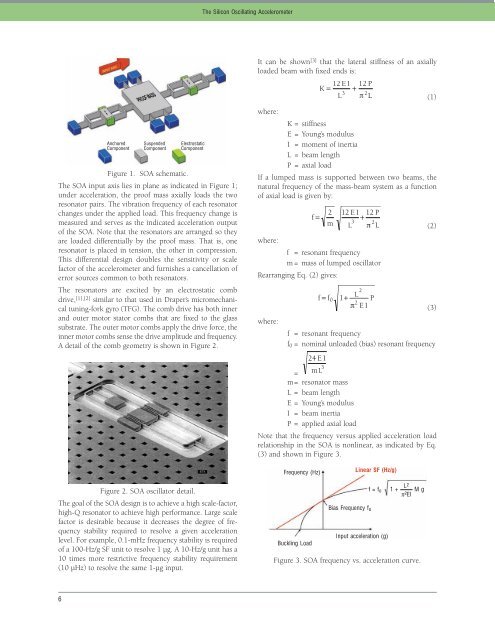TECHNOLOGY DIGEST - Draper Laboratory
TECHNOLOGY DIGEST - Draper Laboratory
TECHNOLOGY DIGEST - Draper Laboratory
You also want an ePaper? Increase the reach of your titles
YUMPU automatically turns print PDFs into web optimized ePapers that Google loves.
Figure 1. SOA schematic.<br />
The SOA input axis lies in plane as indicated in Figure 1;<br />
under acceleration, the proof mass axially loads the two<br />
resonator pairs. The vibration frequency of each resonator<br />
changes under the applied load. This frequency change is<br />
measured and serves as the indicated acceleration output<br />
of the SOA. Note that the resonators are arranged so they<br />
are loaded differentially by the proof mass. That is, one<br />
resonator is placed in tension, the other in compression.<br />
This differential design doubles the sensitivity or scale<br />
factor of the accelerometer and furnishes a cancellation of<br />
error sources common to both resonators.<br />
The resonators are excited by an electrostatic comb<br />
drive, [1],[2] similar to that used in <strong>Draper</strong>’s micromechanical<br />
tuning-fork gyro (TFG). The comb drive has both inner<br />
and outer motor stator combs that are fixed to the glass<br />
substrate. The outer motor combs apply the drive force, the<br />
inner motor combs sense the drive amplitude and frequency.<br />
A detail of the comb geometry is shown in Figure 2.<br />
Figure 2. SOA oscillator detail.<br />
The goal of the SOA design is to achieve a high scale-factor,<br />
high-Q resonator to achieve high performance. Large scale<br />
factor is desirable because it decreases the degree of frequency<br />
stability required to resolve a given acceleration<br />
level. For example, 0.1-mHz frequency stability is required<br />
of a 100-Hz/g SF unit to resolve 1 µg. A 10-Hz/g unit has a<br />
10 times more restrictive frequency stability requirement<br />
(10 µHz) to resolve the same 1-µg input.<br />
6<br />
Anchored<br />
Component<br />
Suspended<br />
Component<br />
Electrostatic<br />
Component<br />
The Silicon Oscillating Accelerometer<br />
It can be shown [3] that the lateral stiffness of an axially<br />
loaded beam with fixed ends is:<br />
where:<br />
K = stiffness<br />
E = Young’s modulus<br />
I = moment of inertia<br />
L = beam length<br />
P = axial load<br />
If a lumped mass is supported between two beams, the<br />
natural frequency of the mass-beam system as a function<br />
of axial load is given by:<br />
where:<br />
f = resonant frequency<br />
m = mass of lumped oscillator<br />
Rearranging Eq. (2) gives:<br />
where:<br />
(1)<br />
(2)<br />
(3)<br />
f = resonant frequency<br />
f0 = nominal unloaded (bias) resonant frequency<br />
=<br />
m= resonator mass<br />
L = beam length<br />
E = Young’s modulus<br />
I = beam inertia<br />
P = applied axial load<br />
Note that the frequency versus applied acceleration load<br />
relationship in the SOA is nonlinear, as indicated by Eq.<br />
(3) and shown in Figure 3.<br />
Frequency (Hz)<br />
Buckling Load<br />
Bias Frequency fo<br />
Linear SF (Hz/g)<br />
f = fo<br />
Input acceleration (g)<br />
1 + M g<br />
π2EI L2 Figure 3. SOA frequency vs. acceleration curve.

















